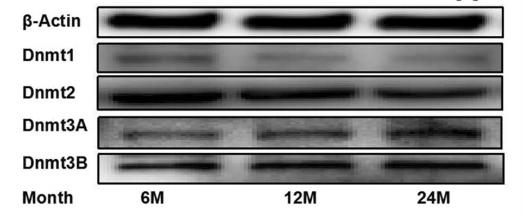Dnmt1 Antibody - #DF7376
| Product: | Dnmt1 Antibody |
| Catalog: | DF7376 |
| Description: | Rabbit polyclonal antibody to Dnmt1 |
| Application: | WB IHC IF/ICC |
| Cited expt.: | WB |
| Reactivity: | Human, Mouse, Rat |
| Prediction: | Bovine, Horse, Sheep |
| Mol.Wt.: | 183kDa; 183kD(Calculated). |
| Uniprot: | P26358 |
| RRID: | AB_2839314 |
Related Downloads
Protocols
Product Info
*The optimal dilutions should be determined by the end user. For optimal experimental results, antibody reuse is not recommended.
*Tips:
WB: For western blot detection of denatured protein samples. IHC: For immunohistochemical detection of paraffin sections (IHC-p) or frozen sections (IHC-f) of tissue samples. IF/ICC: For immunofluorescence detection of cell samples. ELISA(peptide): For ELISA detection of antigenic peptide.
Cite Format: Affinity Biosciences Cat# DF7376, RRID:AB_2839314.
Fold/Unfold
ADCADN; AIM; CXXC finger protein 9; CXXC-type zinc finger protein 9; CXXC9; DNA (cytosine 5 ) methyltransferase 1; DNA (cytosine-5)-methyltransferase 1; DNA methyltransferase 1; DNA methyltransferase HsaI; DNA methyltransferase M.HsaI.; DNA MTase; DNA MTase HsaI; DNMT 1; DNMT; Dnmt1; DNMT1_HUMAN; Dnmt1o; FLJ16293; HSN1E; M.HsaI; MCMT; Met1; MGC104992; mMmul; MommeD2;
Immunogens
A synthesized peptide derived from human Dnmt1, corresponding to a region within the internal amino acids.
Ubiquitous; highly expressed in fetal tissues, heart, kidney, placenta, peripheral blood mononuclear cells, and expressed at lower levels in spleen, lung, brain, small intestine, colon, liver, and skeletal muscle. Isoform 2 is less expressed than isoform 1.
- P26358 DNMT1_HUMAN:
- Protein BLAST With
- NCBI/
- ExPASy/
- Uniprot
MPARTAPARVPTLAVPAISLPDDVRRRLKDLERDSLTEKECVKEKLNLLHEFLQTEIKNQLCDLETKLRKEELSEEGYLAKVKSLLNKDLSLENGAHAYNREVNGRLENGNQARSEARRVGMADANSPPKPLSKPRTPRRSKSDGEAKPEPSPSPRITRKSTRQTTITSHFAKGPAKRKPQEESERAKSDESIKEEDKDQDEKRRRVTSRERVARPLPAEEPERAKSGTRTEKEEERDEKEEKRLRSQTKEPTPKQKLKEEPDREARAGVQADEDEDGDEKDEKKHRSQPKDLAAKRRPEEKEPEKVNPQISDEKDEDEKEEKRRKTTPKEPTEKKMARAKTVMNSKTHPPKCIQCGQYLDDPDLKYGQHPPDAVDEPQMLTNEKLSIFDANESGFESYEALPQHKLTCFSVYCKHGHLCPIDTGLIEKNIELFFSGSAKPIYDDDPSLEGGVNGKNLGPINEWWITGFDGGEKALIGFSTSFAEYILMDPSPEYAPIFGLMQEKIYISKIVVEFLQSNSDSTYEDLINKIETTVPPSGLNLNRFTEDSLLRHAQFVVEQVESYDEAGDSDEQPIFLTPCMRDLIKLAGVTLGQRRAQARRQTIRHSTREKDRGPTKATTTKLVYQIFDTFFAEQIEKDDREDKENAFKRRRCGVCEVCQQPECGKCKACKDMVKFGGSGRSKQACQERRCPNMAMKEADDDEEVDDNIPEMPSPKKMHQGKKKKQNKNRISWVGEAVKTDGKKSYYKKVCIDAETLEVGDCVSVIPDDSSKPLYLARVTALWEDSSNGQMFHAHWFCAGTDTVLGATSDPLELFLVDECEDMQLSYIHSKVKVIYKAPSENWAMEGGMDPESLLEGDDGKTYFYQLWYDQDYARFESPPKTQPTEDNKFKFCVSCARLAEMRQKEIPRVLEQLEDLDSRVLYYSATKNGILYRVGDGVYLPPEAFTFNIKLSSPVKRPRKEPVDEDLYPEHYRKYSDYIKGSNLDAPEPYRIGRIKEIFCPKKSNGRPNETDIKIRVNKFYRPENTHKSTPASYHADINLLYWSDEEAVVDFKAVQGRCTVEYGEDLPECVQVYSMGGPNRFYFLEAYNAKSKSFEDPPNHARSPGNKGKGKGKGKGKPKSQACEPSEPEIEIKLPKLRTLDVFSGCGGLSEGFHQAGISDTLWAIEMWDPAAQAFRLNNPGSTVFTEDCNILLKLVMAGETTNSRGQRLPQKGDVEMLCGGPPCQGFSGMNRFNSRTYSKFKNSLVVSFLSYCDYYRPRFFLLENVRNFVSFKRSMVLKLTLRCLVRMGYQCTFGVLQAGQYGVAQTRRRAIILAAAPGEKLPLFPEPLHVFAPRACQLSVVVDDKKFVSNITRLSSGPFRTITVRDTMSDLPEVRNGASALEISYNGEPQSWFQRQLRGAQYQPILRDHICKDMSALVAARMRHIPLAPGSDWRDLPNIEVRLSDGTMARKLRYTHHDRKNGRSSSGALRGVCSCVEAGKACDPAARQFNTLIPWCLPHTGNRHNHWAGLYGRLEWDGFFSTTVTNPEPMGKQGRVLHPEQHRVVSVRECARSQGFPDTYRLFGNILDKHRQVGNAVPPPLAKAIGLEIKLCMLAKARESASAKIKEEEAAKD
Predictions
Score>80(red) has high confidence and is suggested to be used for WB detection. *The prediction model is mainly based on the alignment of immunogen sequences, the results are for reference only, not as the basis of quality assurance.
High(score>80) Medium(80>score>50) Low(score<50) No confidence
Research Backgrounds
Methylates CpG residues. Preferentially methylates hemimethylated DNA. Associates with DNA replication sites in S phase maintaining the methylation pattern in the newly synthesized strand, that is essential for epigenetic inheritance. Associates with chromatin during G2 and M phases to maintain DNA methylation independently of replication. It is responsible for maintaining methylation patterns established in development. DNA methylation is coordinated with methylation of histones. Mediates transcriptional repression by direct binding to HDAC2. In association with DNMT3B and via the recruitment of CTCFL/BORIS, involved in activation of BAG1 gene expression by modulating dimethylation of promoter histone H3 at H3K4 and H3K9. Probably forms a corepressor complex required for activated KRAS-mediated promoter hypermethylation and transcriptional silencing of tumor suppressor genes (TSGs) or other tumor-related genes in colorectal cancer (CRC) cells. Also required to maintain a transcriptionally repressive state of genes in undifferentiated embryonic stem cells (ESCs). Associates at promoter regions of tumor suppressor genes (TSGs) leading to their gene silencing. Promotes tumor growth.
Sumoylated; sumoylation increases activity.
Acetylation on multiple lysines, mainly by KAT2B/PCAF, regulates cell cycle G(2)/M transition. Deacetylation of Lys-1349 and Lys-1415 by SIRT1 increases methyltransferase activity.
Phosphorylation of Ser-154 by CDKs is important for enzymatic activity and protein stability. Phosphorylation of Ser-143 by AKT1 prevents methylation by SETD7 therebye increasing DNMT1 stability.
Methylation at Lys-142 by SETD7 promotes DNMT1 proteasomal degradation.
Ubiquitinated by UHRF1; interaction with USP7 counteracts ubiquitination by UHRF1 by promoting deubiquitination and preventing degradation by the proteasome.
Nucleus.
Ubiquitous; highly expressed in fetal tissues, heart, kidney, placenta, peripheral blood mononuclear cells, and expressed at lower levels in spleen, lung, brain, small intestine, colon, liver, and skeletal muscle. Isoform 2 is less expressed than isoform 1.
The N-terminal part is required for homodimerization and acts as a regulatory domain.
The CXXC-type zinc finger specifically binds to unmethylated CpG dinucleotides, positioning the autoinhibitory linker between the DNA and the active site, thus providing a mechanism to ensure that only hemimethylated CpG dinucleotides undergo methylation.
Belongs to the class I-like SAM-binding methyltransferase superfamily. C5-methyltransferase family.
Research Fields
· Human Diseases > Cancers: Overview > MicroRNAs in cancer.
· Metabolism > Amino acid metabolism > Cysteine and methionine metabolism.
· Metabolism > Global and overview maps > Metabolic pathways.
References
Application: WB Species: Mouse Sample: GCs
Application: WB Species: rat Sample: ovaries
Application: WB Species: Human Sample: HL-60 Cells
Application: WB Species: Rat Sample:
Restrictive clause
Affinity Biosciences tests all products strictly. Citations are provided as a resource for additional applications that have not been validated by Affinity Biosciences. Please choose the appropriate format for each application and consult Materials and Methods sections for additional details about the use of any product in these publications.
For Research Use Only.
Not for use in diagnostic or therapeutic procedures. Not for resale. Not for distribution without written consent. Affinity Biosciences will not be held responsible for patent infringement or other violations that may occur with the use of our products. Affinity Biosciences, Affinity Biosciences Logo and all other trademarks are the property of Affinity Biosciences LTD.




